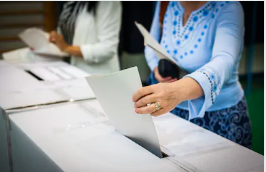Red wave, blue wave, pink wave
By The Policy Circle Team
 Red wave, blue wave, pink wave!? It’s beginning to sound like a Dr. Seuss rhyme, but the latest catch phrase of ‘the pink wave’ in describing this most recent 2018 midterm election is an exciting change of pace — one used to articulate the power of women on the ballot and at the polls.
Red wave, blue wave, pink wave!? It’s beginning to sound like a Dr. Seuss rhyme, but the latest catch phrase of ‘the pink wave’ in describing this most recent 2018 midterm election is an exciting change of pace — one used to articulate the power of women on the ballot and at the polls.
This November saw “a record number of women filed to run for office, and the amount of money raised by women for women was also an all-time high” according to Real Clear Politics.
Among the record breaking that took place, the largest number of female gubernatorial candidates succeeded in winning nine governorships – up three from 2016. Five female incumbents from Alabama (R), Iowa (R), New Mexico (R), Oregon (D), Rhode Island (D) held their offices. Oklahoma governor, Mary Fallin (R), stepped down due to term limits. And the newly elected female governors in South Dakota (R), Michigan (D), Maine (D), and Kansas (D) mean that women now lead 18% of the states. The recent midterms also increased female representation in Congress from 20% to 23%. With at least 102 women to serve in the U.S. House of Representatives as more elections are to be decided, we have achieved the milestone of over 100 women serving in the House.
“When you think about what is a representative democracy, making sure that the perspectives and experiences of the entire population are mirrored in those legislative institutions, whether it’s at the state level or the federal level, is important,” said Debbie Walsh, director of Rutgers’ Center for American Women and Politics (CAWP). “Those experiences shape the policy priorities of those elected officials.” (USA Today)
In order to increase female representation, more women need to run who focus on issues that matter to our nation such as healthcare, the economy, education, and safety. At The Policy Circle, we’ve seen that female voters are engaged in improving their communities. According to CAWP, the percentage of voter turnout by women has surpassed that of men since the 1980 presidential election. Gender aside, voter turnout for this midterm election hit a 50 year high with approximately 47% of eligible voters casting a ballot according to the United States Election project. This is a stark contrast to the last midterms in 2014 which had the lowest voter turnout since 1942.
So what issues mattered to women this November? And why did 60% of women who voted between the two major parties, choose to vote democratic. Take a look at this Washington Post profile on the faces of women in the 2018 midterm. Their stories will shed more light on the phenomenon at the polls beyond the statistics on gender, education and suburban gaps among voters.
It’s a movement!
Recommend a Circle Leader. Especially in Georgia, California, Wisconsin, Michigan, Kansas and Arizona where circles are sprouting.
Start a Circle in your community. Your community may be your profession or your neighborhood, or both. The Policy Circle is a simple way to practice the language of leaders with the facts and the space to be at ease with weighing in on the impact of policy.
Invest in The Policy Circle. Together let’s build a network of women who want to be part of the dialogue on the impact of policy in their lives.
The Policy Circle is a 501(c)3 that provides a fact-based, nonpartisan framework built to inspire women living in the same community to connect, learn about and discuss economic policies that impact their lives. Women across the nation are taking a leadership role in the public policy dialogue on what human creativity can accomplish in an open economy.